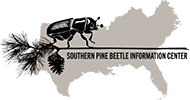Abstract
Forest biotic populations and communities are undergoing irreversible changes due to climatic perturbations, and these effects may be exacerbated by insect pests. In the southeastern United States (U.S.), Dendroctonus frontalis is one of the most important forest pests that can cause substantial tree mortality over large geographic areas. As life-history of D. frontalis is dependent on environmental conditions, our objective was to determine the effects of climatic variables on the species occurrence of D. frontalis and their main predator, Thanasimus dubius. U.S. Department of Agriculture – Forest Service beetle trapping data (proxy for true abundance) for 2014–2018 were assessed with nine climatic variables including: (1) average monthly minimum, maximum, and mean temperatures; (2) mean winter temperature; (3) minimum, maximum and mean annual temperature; and (4) cumulative winter and annual precipitation. Variable selection was performed using least absolute selection and shrinkage operator (LASSO), and selected variables were fit to varying coefficient generalized additive models (GAMs). Minimum temperatures for February and March and maximum temperatures for January and prior year August were found to have a significant effect on D. frontalis numbers, and model accuracy was ~89%. Beetle suitability was assessed for 1981–2100 under three different shared socioeconomic pathways (SSP). The model indicated that the suitability of D. frontalis has increased from 1981 to 2019 in certain regions of Alabama, Mississippi, and Georgia, while Arkansas, Kentucky, Louisiana, North Carolina, Tennessee, East Texas, and Virginia had low suitability. Future projections indicated comparable D. frontalis numbers to current numbers under the lowest SSP of 2.1◦C by year 2100, but D. frontalis may decrease under higher warming projections. The same climatic predictors influenced T. dubius, except average September maximum temperature replaced August maximum temperatures in the model. Understanding how these abiotic factors influence forest pest populations may better guide
Keywords
Bark beetle, Climate change, Disturbance, Pinus, Predator, Range expansion, Southern pine beetle
To read the full article please visit the link below:
Munro, Holly L., Cristian R. Montes, Stephen M. Kinane, and Kamal J. K. Gandhi. 2021. “Through Space and Time: Predicting Numbers of an Eruptive Pine Tree Pest and Its Predator under Changing Climate Conditions.” Forest Ecology and Management 483 (March): 118770. https://doi.org/10.1016/j.foreco.2020.118770.
